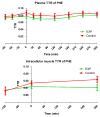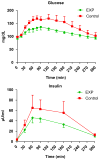Muscle protein synthesis in cancer patients can be stimulated with a specially formulated medical food
- PMID: 21683485
- PMCID: PMC3964623
- DOI: 10.1016/j.clnu.2011.05.008
Muscle protein synthesis in cancer patients can be stimulated with a specially formulated medical food
Abstract
Objective: Maintenance of muscle mass is crucial to improving outcome and quality of life in cancer patients. Stimulating muscle protein synthesis is the metabolic basis for maintaining muscle mass, but in cancer patients normal dietary intake has minimal effects on muscle protein synthesis. Adding leucine to high protein supplements stimulates muscle protein synthesis in healthy older subjects. The objective was to determine if a specially formulated medical food, high in leucine and protein, stimulates muscle protein synthesis acutely in individuals with cancer to a greater extent than a conventional medical food.
Design: A randomized, controlled, double-blind, parallel-group design was used in 25 patients with radiographic evidence of cancer. Patients were studied before their cancer treatment was started or 4 weeks after their treatment was completed or halted. The fractional rate of muscle protein synthesis (FSR) was measured using the tracer incorporation technique with L-[ring-(13)C(6)]-phenylalanine. The experimental group (n = 13) received a medical food containing 40 g protein, based on casein and whey protein and enriched with 10% free leucine and other specific components, while the control group (n = 12) was given a conventionally used medical food based on casein protein alone (24 g). Blood and muscle samples were collected in the basal state and 5h hours after ingestion of the medical foods.
Results: The cancer patients were in an inflammatory state, as reflected by high levels of C-reactive protein (CRP), IL-1 β and TNF-α, but were not insulin resistant (HOMA). After ingestion of the experimental medical food, plasma leucine increased to about 400 μM as compared to the peak value of 200 μM, after the control medical food (p < 0.001). Ingestion of the experimental medical food increased muscle protein FSR from 0.073 (SD: 0.023) to 0.097 (SD: 0.033) %/h (p = 0.0269). In contrast, ingestion of the control medical food did not increase muscle FSR; 0.073 (SD: 0.022) and 0.065 (SD: 0.028) %/h.
Conclusions: In cancer patients, conventional nutritional supplementation is ineffective in stimulating muscle protein synthesis. This anabolic resistance can be overcome with a specially formulated nutritional supplement.
2011 Elsevier Ltd and European Society for Clinical Nutrition and Metabolism. All rights reserved.
Conflict of interest statement
Dr. Wolfe is a member of the Danone Research Advisory Board and received compensation. Mr. Memelink and Dr. van Helvoort are employed by Nutricia Advanced Medical Nutrition, Danone Research – Centre for Specialised Nutrition. Dr. Ferrando, Dr. Deutz, Mr. Schutzler and Mr. Spencer have no conflict of interest to declare.
Figures





Similar articles
-
Postprandial muscle protein synthesis is higher after a high whey protein, leucine-enriched supplement than after a dairy-like product in healthy older people: a randomized controlled trial.Nutr J. 2014 Jan 22;13:9. doi: 10.1186/1475-2891-13-9. Nutr J. 2014. PMID: 24450500 Free PMC article. Clinical Trial.
-
Both basal and post-prandial muscle protein synthesis rates, following the ingestion of a leucine-enriched whey protein supplement, are not impaired in sarcopenic older males.Clin Nutr. 2017 Oct;36(5):1440-1449. doi: 10.1016/j.clnu.2016.09.023. Epub 2016 Sep 29. Clin Nutr. 2017. PMID: 27743615
-
Supplementing Breakfast with a Vitamin D and Leucine-Enriched Whey Protein Medical Nutrition Drink Enhances Postprandial Muscle Protein Synthesis and Muscle Mass in Healthy Older Men.J Nutr. 2017 Dec;147(12):2262-2271. doi: 10.3945/jn.117.252510. Epub 2017 Aug 23. J Nutr. 2017. PMID: 28835387 Clinical Trial.
-
Dietary proteins and amino acids in the control of the muscle mass during immobilization and aging: role of the MPS response.Amino Acids. 2017 May;49(5):811-820. doi: 10.1007/s00726-017-2390-9. Epub 2017 Feb 7. Amino Acids. 2017. PMID: 28175999 Review.
-
Efficacy and Safety of Leucine Supplementation in the Elderly.J Nutr. 2016 Dec;146(12):2625S-2629S. doi: 10.3945/jn.116.230771. Epub 2016 Nov 9. J Nutr. 2016. PMID: 27934654 Free PMC article. Review.
Cited by
-
In vitro chemotherapy-associated muscle toxicity is attenuated with nutritional support, while treatment efficacy is retained.Oncotarget. 2022 Oct 8;13:1094-1108. doi: 10.18632/oncotarget.28279. Oncotarget. 2022. PMID: 36242541 Free PMC article.
-
Nutrition in Cancer Patients.J Clin Med. 2019 Aug 14;8(8):1211. doi: 10.3390/jcm8081211. J Clin Med. 2019. PMID: 31416154 Free PMC article. Review.
-
Understanding the Role of Exercise in Cancer Cachexia Therapy.Am J Lifestyle Med. 2017 Aug 17;13(1):46-60. doi: 10.1177/1559827617725283. eCollection 2019 Jan-Feb. Am J Lifestyle Med. 2017. PMID: 30627079 Free PMC article.
-
Linking Cancer Cachexia-Induced Anabolic Resistance to Skeletal Muscle Oxidative Metabolism.Oxid Med Cell Longev. 2017;2017:8018197. doi: 10.1155/2017/8018197. Epub 2017 Dec 11. Oxid Med Cell Longev. 2017. PMID: 29375734 Free PMC article. Review.
-
Bed rest promotes reductions in walking speed, functional parameters, and aerobic fitness in older, healthy adults.J Gerontol A Biol Sci Med Sci. 2015 Jan;70(1):91-6. doi: 10.1093/gerona/glu123. Epub 2014 Aug 13. J Gerontol A Biol Sci Med Sci. 2015. PMID: 25122628 Free PMC article. Clinical Trial.
References
-
- Evans WJ, Morley JE, Argiles J, Bales C, Baracos V, Guttridge D, et al. Cachexia: a new definition. Clin Nutr. 2008;27(6):793–9. - PubMed
-
- Tisdale MJ. Mechanisms of cancer cachexia. Physiol Rev. 2009;89(2):381–410. - PubMed
-
- Biolo G, Antonione R, Barazzoni R, Zanetti M, Guarnieri G. Mechanisms of altered protein turnover in chronic diseases: a review of human kinetic studies. Curr Opin Clin Nutr Metab Care. 2003;6(1):55–63. - PubMed
-
- Shaw JH, Humberstone DA, Douglas RG, Koea J. Leucine kinetics in patients with benign disease, non-weight-losing cancer, and cancer cachexia: studies at the whole-body and tissue level and the response to nutritional support. Surgery. 1991;109(1):37–50. - PubMed
-
- De Blaauw I, Deutz NE, Von Meyenfeldt MF. Metabolic changes in cancer cachexia - first of two parts. Clin Nutr. 1997;16(4):169–76. - PubMed
Publication types
MeSH terms
Substances
Grants and funding
LinkOut - more resources
Full Text Sources
Other Literature Sources
Research Materials
Miscellaneous

